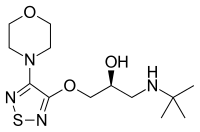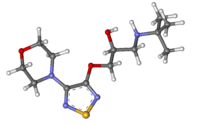Timolol
Timolol is a medication used either by mouth or as eye drops.[2][3] As eye drops it is used to treat increased pressure inside the eye such as in ocular hypertension and glaucoma.[2] By mouth it is used for high blood pressure, chest pain due to insufficient blood flow to the heart, to prevent further complications after a heart attack, and to prevent migraines.[3]
 | |
 | |
| Clinical data | |
|---|---|
| Trade names | Betimol, others[1] |
| AHFS/Drugs.com | Monograph |
| MedlinePlus | a602022 |
| License data | |
| Pregnancy category | |
| Routes of administration | By mouth, topical (eye drop) |
| Drug class | Beta blocker |
| ATC code | |
| Legal status | |
| Legal status |
|
| Pharmacokinetic data | |
| Bioavailability | 60% |
| Metabolism | Liver (80%) |
| Elimination half-life | 2.5–5 hours |
| Excretion | Kidney |
| Identifiers | |
IUPAC name
| |
| CAS Number | |
| PubChem CID | |
| IUPHAR/BPS | |
| DrugBank | |
| ChemSpider | |
| UNII | |
| KEGG | |
| ChEBI | |
| ChEMBL | |
| CompTox Dashboard (EPA) | |
| ECHA InfoCard | 100.043.651 |
| Chemical and physical data | |
| Formula | C13H24N4O3S |
| Molar mass | 316.421 g/mol g·mol−1 |
| 3D model (JSmol) | |
SMILES
| |
InChI
| |
| (verify) | |
Common side effects with the drops is irritation of the eye.[2] Common side effects by mouth include tiredness, slow heart beat, itchiness, and shortness of breath.[3] Other side effects include masking the symptoms of low blood sugar in those with diabetes.[2] Use is not recommended in those with asthma, uncompensated heart failure, or COPD.[2] It is unclear if use during pregnancy is safe for the baby.[4] Timolol is a non-selective beta blocker.[2]
Timolol was patented in 1968 and came into medical use in 1978.[5] It is on the World Health Organization's List of Essential Medicines, the most effective and safe medicines needed in a health system.[6] Timolol is available as a generic medication.[2] The wholesale cost in the developing world is about US$0.86–2.29 per 5 ml bottle.[7] In the United States it costs US$25–50 per month.[8] In 2016 it was the 142nd most prescribed medication in the United States with more than four million prescriptions.[9]
Medical uses
By mouth
In its by mouth form, it is used:
- to treat high blood pressure
- to prevent heart attacks
- to prevent migraine headaches[10]
Eye drops
In its eye drop form it is used to treat open-angle and, occasionally, secondary glaucoma.[2] The mechanism of action of timolol is probably the reduction of the formation of aqueous humor[2] in the ciliary body in the eye. It was the first β blocker approved for topical use in treatment of glaucoma in the USA (1978).[11] When used by itself, it depresses intraocular pressure (IOP) 18–34% below baseline within first few treatments. However, there are short-term escape and long-term drift effects in some patients. That is, tolerance develops. It may reduce the extent of diurnal IOP curve up to 50%. IOP higher during sleep. Efficacy of timolol in lowering IOP during the sleep period may be limited.[12][13][14] It is 5–10× more potent β blocker than propranolol. Timolol is light-sensitive; it is usually preserved with 0.01% benzalkonium chloride (BAC), but also comes BAC-free. Can also be used in adjunctive therapy with pilocarpine or carbonic anhydrase inhibitors.[15]
A Cochrane review compared the effect of timolol versus brimonidine in slowing the progression of open angle glaucoma in adult participants but found insufficient evidence to come to conclusions.[16]
On the skin
In its gel form it is used on the skin to treat infantile hemangiomas.[17]
Contraindications
The medication should not be taken by individuals with:
- An allergy to timolol or any other beta-blockers
- Asthma or severe chronic obstructive bronchitis
- A slow heart rate (bradycardia), or a heart block
- Heart failure[18]
Side effects
The most serious possible side effects include cardiac arrhythmias and severe bronchospasms. Timolol can also lead to fainting, congestive heart failure, depression, confusion, worsening of Raynaud's syndrome and impotence.
Side effects when given in the eye include: burning sensation, eye redness, superficial punctate keratopathy, corneal numbness.
Formulations
It is available in tablet and liquid formulations.
For ophthalmic use, timolol is also available combined:
- with carbonic anhydrase inhibitors:
- timolol and brinzolamide
- timolol and dorzolamide
- with α2 agonists:
- with prostaglandin analogs:
- timolol and latanoprost
- timolol and travoprost
Brand names
Timolol is marketed under many trade names worldwide.[1] Timolol eye drops are marketed under the brand name Istalol among others.[19][20]
References
- "Timolol". Drugs.com. Archived from the original on 7 March 2016. Retrieved 28 December 2016.
- "Timolol eent". The American Society of Health-System Pharmacists. Archived from the original on 28 December 2016. Retrieved 8 December 2016.
- "Timolol Maleate". The American Society of Health-System Pharmacists. Archived from the original on 28 December 2016. Retrieved 8 December 2016.
- "Timolol ophthalmic Use During Pregnancy". The American Society of Health-System Pharmacists. Archived from the original on 28 December 2016. Retrieved 28 December 2016.
- Fischer, Janos; Ganellin, C. Robin (2006). Analogue-based Drug Discovery. John Wiley & Sons. p. 460. ISBN 9783527607495. Archived from the original on 2016-12-28.
- "World Health Organization model list of essential medicines: 21st list 2019". World Health Organization (WHO). 2019. hdl:10665/325771. Cite journal requires
|journal=(help) - "Timolol Maleate". International Drug Price Indicator Guide. Retrieved 8 December 2016.
- Hamilton, Richart (2015). Tarascon Pocket Pharmacopoeia 2015 Deluxe Lab-Coat Edition. Jones & Bartlett Learning. p. 411. ISBN 9781284057560.
- "The Top 300 of 2019". ClinCalc.com. Retrieved 22 December 2018.
- Dawn A. Marcus; Philip A. Bain (27 February 2009). Effective Migraine Treatment in Pregnant and Lactating Women: A Practical Guide. シュプリンガー・ジャパン株式会社. pp. 141–. ISBN 978-1-60327-438-8. Archived from the original on 5 November 2017. Retrieved 14 November 2010.
- Sambhara, Deepak; Aref, Ahmad A. (13 November 2013). "Glaucoma management: relative value and place in therapy of available drug treatments". Therapeutic advances in chronic disease. 5 (1): 30–43. doi:10.1177/2040622313511286. ISSN 2040-6223. PMC 3871276. PMID 24381726.
- Liu, John H. K.; Kripke, Daniel F.; Weinreb, Robert N. (September 2004). "Comparison of the nocturnal effects of once-daily timolol and latanoprost on intraocular pressure". American Journal of Ophthalmology. 138 (3): 389–395. doi:10.1016/j.ajo.2004.04.022. ISSN 0002-9394. PMID 15364220.
- Liu, John H. K.; Medeiros, Felipe A.; Slight, J. Rigby; Weinreb, Robert N. (March 2009). "Comparing diurnal and nocturnal effects of brinzolamide and timolol on intraocular pressure in patients receiving latanoprost monotherapy". Ophthalmology. 116 (3): 449–454. doi:10.1016/j.ophtha.2008.09.054. ISSN 1549-4713. PMID 19157559.
- Liu, John H. K.; Slight, John R.; Vittitow, Jason L.; Scassellati Sforzolini, Baldo; Weinreb, Robert N. (September 2016). "Efficacy of Latanoprostene Bunod 0.024% Compared With Timolol 0.5% in Lowering Intraocular Pressure Over 24 Hours". American Journal of Ophthalmology. 169: 249–257. doi:10.1016/j.ajo.2016.04.019. ISSN 1879-1891. PMID 27457257.
- Strohmaier, K; Snyder, E; Adamsons, I (July 1998). "A multicenter study comparing dorzolamide and pilocarpine as adjunctive therapy to timolol: patient preference and impact on daily life". J Am Optom Assoc. 69 (7): 441–51. PMID 9697378.
- Sena DF, Lindsley K (2017). "Neuroprotection for treatment of glaucoma in adults". Cochrane Database Syst Rev. 1 (1): CD006539. doi:10.1002/14651858.CD006539.pub4. PMC 5370094. PMID 28122126.
- Novoa, Monica; Baselga, Eulalia; Beltran, Sandra; Giraldo, Lucia; Shahbaz, Ali; Pardo-Hernandez, Hector; Arevalo-Rodriguez, Ingrid (18 April 2018). "Interventions for infantile haemangiomas of the skin". Cochrane Database of Systematic Reviews. 4: CD006545. doi:10.1002/14651858.CD006545.pub3. PMC 6513200. PMID 29667726.
- "Package leaflet: Information for the user Timolol" (PDF). hpra.ie.
- "Generic Istalol Availability". Drugs.com. Retrieved 2019-06-20.
- "Istalol". Drugs.com. 1 August 2018. Retrieved 19 July 2019.